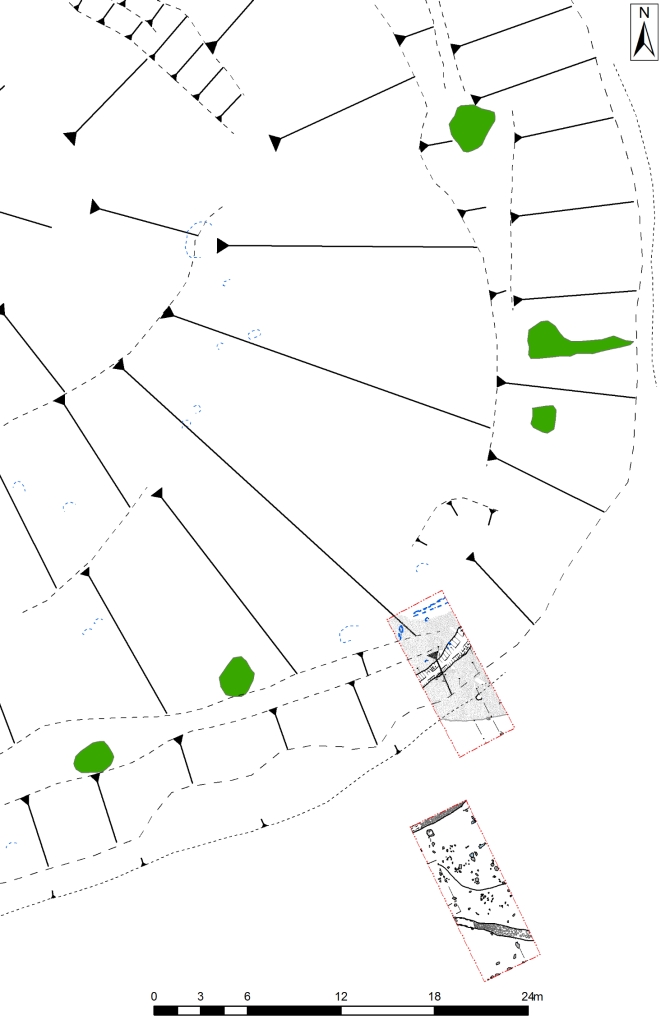County: Meath Site name: Dowth
Sites and Monuments Record No.: ME020-023 Licence number: 15E0244
Author: Clíodhna Ní Lionáin (Devenish) and Steve Davis (UCD School of Archaeology)
Site type: Mound
Period/Dating: —
ITM: E 703327m, N 773551m
Latitude, Longitude (decimal degrees): 53.701421, -6.435146
Carried out over a five-week period in the summer of 2015, this research excavation at the site of a large mound (ME020-023) in Dowth townland, Co. Meath was funded by the landowners (Devenish and the Brennan family), and formed part of a research programme led by Dr Steve Davis, UCD School of Archaeology. The excavation was directed by Dr Clíodhna Ní Lionáin (Project Archaeologist, Lands at Dowth Hall).
ME020-023 is a large, sub-circular mound (c. 82m [east-west] x 91m x 3.45-12m high) located on a river terrace overlooking the Boyne, which flows 120m south of the monument. The higher ground to the north and north-west of the mound reduces its visual impact from these directions, and the mound is best seen from the river. The excavation strategy was informed by a programme of geophysical survey (12R0080), which identified an anomaly around the mound perimeter, and possible archaeological features south of the mound. The primary aim of the excavation was to better understand the nature of this large mound and to ground-truth the geophysical data.
Located in the south-east part of the mound, Trench 1 (4m x 10m) targeted the possible perimeter feature. Excavation revealed that the mound is artificial and built on a low shale outcrop, around which a blunted V-shaped, rock-cut ditch (2.1-3.1m wide at top, 0.3-0.4m wide at base) was dug. The relatively shallow (1m deep) ditch does not appear to have been defensive in nature, and its purpose could have been to define or delimit the monument. No dateable material was found in the lower ditch fills. However, the ditch was cut into and sealed by hill wash/mound slippage deposits, which contained a mix of prehistoric lithics, including a barbed-and-tanged arrowhead, and occasional sherds of medieval pottery. The presence of medieval artefacts could reflect later intrusions arising from bioturbation or indicate the use of soil containing residual prehistoric and medieval material to construct the mound. A post-hole and pit were found in a similar stratigraphic position, but it was not possible to determine if they were contemporary with the ditch. The mixed nature of the artefact assemblage and the lack of dating material makes it difficult to assign the construction of the mound to a particular period. Whatever its date, it is clear that its construction would have required a considerable investment of time and labour.
Situated slightly further west, Trench 2 (4m x 11m) targeted a possible rectangular structure identified in the geophysical survey on the platform to the south of the mound. Two small pits, two modern field drains, a number of small, thin lenses of fire-affected soil, and two hillwash deposits containing a significant quantity of prehistoric lithics (including a hollow scraper), and a sherd of Beaker pottery, were found. No elements of the possible rectangular structure were identified. It is possible that these features were very ephemeral or were located beyond the extent of the trench.
This excavation has shown that ME020-023 is an artificial mound, which is delimited by a ditch. The chronology of both these events—construction and demarcation—are as yet unknown, and further excavation is required to resolve these issues and to understand the function of the site. The artefact assemblage has shown that there was considerable prehistoric activity in the area. Although only a small number of the artefacts are diagnostic, they appear to point towards a Late Neolithic/Chalcolithic date. Though occurring in much lesser quantities, the assemblage also shows that there was medieval and post-medieval activity. At the time of writing, post-excavation work and research is still ongoing.
[caption id="attachment_38965" align="aligncenter" width="659"] Post-excavation plan[/caption]
Post-excavation plan[/caption]
UCD School of Archaeology, Belfield, Dublin 4